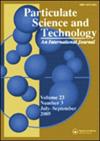Study on the relation of bubble behavior and bed density in gas–solid separation fluidized bed using electrical capacitance tomography
IF 1.5
4区 工程技术
Q3 ENGINEERING, CHEMICAL
引用次数: 0
Abstract
AbstractGas–solid Fluidized bed technology has a pivotal role in coal separation. Bubble movement behavior is an important factor affecting the fluidization stability. Fluidized bed measurement is an essential link in the bubble behavior study. As the main evaluation parameters, the concentration distribution and density distribution can reflect the bubble movement behavior. This work uses a noninvasive method of electrical capacitance tomography (ECT) for fluidized bed measurements, combined with COMSOL simulation validation for real-time imaging of bubbles in Geldart Group B magnetite powder particles. Meanwhile, the most suitable reconstruction algorithm for gas–solid separation fluidized bed is selected from three image reconstruction algorithms. And then concentration distribution and density distribution are analyzed. The results show that under reasonable gas velocity conditions (U–Umf =2.28 and 3.17 cm/s), the central region ([0, 1/4]) concentrations of [0.43–0.45] and [0.39–0.42] and densities of [1.98–2.06 g/cm3] and [1.86–1.96 g/cm3] are obtained by ECT measurements, respectively. Finally, the bed density obtained from the ECT sensors in the experiment was validated using three different bed density models. The error can be controlled to within 20%, which indicates that the ECT measurement method has a fairly high reliability and accuracy in dry coal beneficiation field.Keywords: Gas–solid fluidized bedelectrical capacitance tomography (ECT)bubble movement behaviorbed density Disclosure statementNo potential conflict of interest was reported by the author(s).Additional informationFundingThe research work is financially supported by China National Funds for Distinguished Young Scientists (52125403), Natural Science Foundation of Jiangsu Province (BK20200651), National Natural Science Foundation of China (52104276, 52261135540, 52220105008, 51974306), the Postgraduate Research & Practice Innovation Program of Jiangsu Province (KYCX23_2815); the Graduate Innovation Program of China University of Mining and Technology (2023WLKXJ065), the Fundamental Research Funds for the Central Universities (2023XSCX020).气固分离流化床气泡行为与床层密度关系的电容量层析成像研究
气固流化床技术在煤选别中起着举足轻重的作用。气泡的运动行为是影响流化稳定性的重要因素。流化床测量是气泡行为研究的一个重要环节。浓度分布和密度分布是反映气泡运动特性的主要评价参数。这项工作使用了一种无创的电容断层扫描(ECT)方法进行流化床测量,并结合COMSOL模拟验证,对Geldart B族磁铁矿粉末颗粒中的气泡进行实时成像。同时,从三种图像重建算法中选择最适合气固分离流化床的图像重建算法。然后分析了其浓度分布和密度分布。结果表明:在合理的气速条件下(U-Umf =2.28和3.17 cm/s), ECT测量得到的中心区域([0,1 /4])浓度分别为[0.43 ~ 0.45]和[0.39 ~ 0.42],密度分别为[1.98 ~ 2.06 g/cm3]和[1.86 ~ 1.96 g/cm3]。最后,使用三种不同的床层密度模型对实验中ECT传感器获得的床层密度进行验证。误差可控制在20%以内,表明电痉挛测量方法在干煤选矿领域具有较高的可靠性和精度。关键词:气固流化电容层析成像(ECT)气泡运动行为密度披露声明作者未报告潜在的利益冲突。基金资助:国家杰出青年科学基金项目(52125403)、江苏省自然科学基金项目(BK20200651)、国家自然科学基金项目(52104276,52261135540,52220105008,51974306)、江苏省研究生科研与实践创新项目(KYCX23_2815);中国矿业大学研究生创新项目(2023WLKXJ065)、中央高校基本科研业务费专项资金(2023XSCX020)。
本文章由计算机程序翻译,如有差异,请以英文原文为准。
求助全文
约1分钟内获得全文
求助全文
来源期刊

Particulate Science and Technology
工程技术-工程:化工
CiteScore
4.40
自引率
4.00%
发文量
86
审稿时长
12 months
期刊介绍:
Particulate Science and Technology, an interdisciplinary journal, publishes papers on both fundamental and applied science and technology related to particles and particle systems in size scales from nanometers to millimeters. The journal''s primary focus is to report emerging technologies and advances in different fields of engineering, energy, biomaterials, and pharmaceutical science involving particles, and to bring institutional researchers closer to professionals in industries.
Particulate Science and Technology invites articles reporting original contributions and review papers, in particular critical reviews, that are relevant and timely to the emerging and growing fields of particle and powder technology.
 求助内容:
求助内容: 应助结果提醒方式:
应助结果提醒方式:


